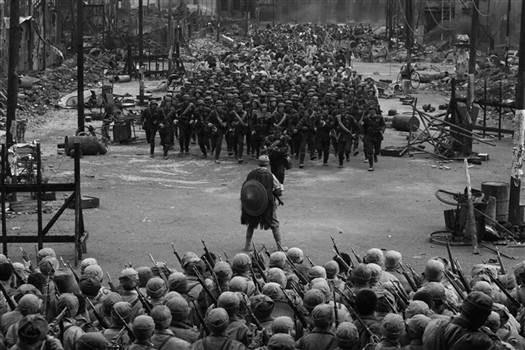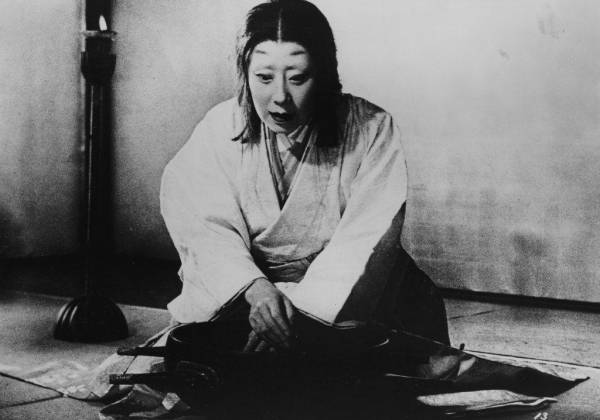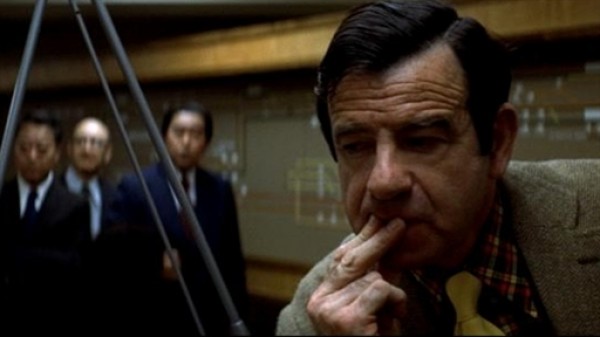
Walter Matthau tries to get to the bottom of a bizarre subway heist in THE TAKING OF PELHAM ONE TWO THREE
THE TAKING OF PELHAM ONE TWO THREE (Joseph Sargent, 1974)
Film Forum
209 West Houston St.
September 2-13
212-727-8110
www.filmforum.org
 Loosely adapted from the book by John Godey, The Taking of Pelham One Two Three wonderfully captures the cynicism of 1970s New York City. Four heavily armed and mustached men — Mr. Blue (Robert Shaw), Mr. Green (Martin Balsam), Mr. Gray (Hector Elizondo), and Mr. Brown (Earl Hindman), colorful pseudonyms that influenced Quentin Tarantino’s Reservoir Dogs — hijack an uptown 4 train, demanding one million dollars in one hour from a nearly bankrupt city or else they will kill all eighteen passengers, one at a time, minute by minute. The hapless mayor (Lee Wallace) is in bed with the flu, so Deputy Mayor Warren LaSalle (Tony Roberts) takes charge on the political end while transit detective Lt. Zachary Garber (a great Walter Matthau) and Inspector Daniels (Julius Harris) of the NYPD team up to try to figure out just how in the world the criminals expect to get away with the seemingly impossible heist. Directed by Joseph Sargent (Sybil), the film offers a nostalgic look back at a bygone era, before technology radically changed the way trains are run and police work is handled. The film also features a very funny, laconic Jerry Stiller as Lt. Rico Patrone and the beloved Kenneth McMillan as the borough commander. The film was remade as a television movie in 1998, starring Edward James Olmos, Vincent D’Onofrio, and Lorraine Bracco, and as an embarrassingly bad big-budget bomb in 2009 by Tony Scott, who we’re hoping won’t ruin his upcoming remake of The Warriors as well.
Loosely adapted from the book by John Godey, The Taking of Pelham One Two Three wonderfully captures the cynicism of 1970s New York City. Four heavily armed and mustached men — Mr. Blue (Robert Shaw), Mr. Green (Martin Balsam), Mr. Gray (Hector Elizondo), and Mr. Brown (Earl Hindman), colorful pseudonyms that influenced Quentin Tarantino’s Reservoir Dogs — hijack an uptown 4 train, demanding one million dollars in one hour from a nearly bankrupt city or else they will kill all eighteen passengers, one at a time, minute by minute. The hapless mayor (Lee Wallace) is in bed with the flu, so Deputy Mayor Warren LaSalle (Tony Roberts) takes charge on the political end while transit detective Lt. Zachary Garber (a great Walter Matthau) and Inspector Daniels (Julius Harris) of the NYPD team up to try to figure out just how in the world the criminals expect to get away with the seemingly impossible heist. Directed by Joseph Sargent (Sybil), the film offers a nostalgic look back at a bygone era, before technology radically changed the way trains are run and police work is handled. The film also features a very funny, laconic Jerry Stiller as Lt. Rico Patrone and the beloved Kenneth McMillan as the borough commander. The film was remade as a television movie in 1998, starring Edward James Olmos, Vincent D’Onofrio, and Lorraine Bracco, and as an embarrassingly bad big-budget bomb in 2009 by Tony Scott, who we’re hoping won’t ruin his upcoming remake of The Warriors as well.

Harvey Keitel is not just a cop — he’s a cop on the edge — in Abel Ferrara’s cult classic BAD LIEUTENANT
The Taking of Pelham One Two Three is screening on Sunday, September 4, in a double feature with Gordon Douglas’s 1968 police drama, The Detective, starring Frank Sinatra and Lee Remick, as part of Film Forum’s “NYPD” festival, paying tribute to the tenth anniversary of the amazing, selfless work done by New York’s Finest on September 11 (as well as every day of every year). The festival, which runs September 2-13, begins today and tomorrow with a pair of Otto Preminger flicks, 1944’s Laura and 1950’s Where the Sidewalk Ends, and continues with such cool double features as Madigan (Don Siegel, 1968) and Report to the Commissioner (Milton Kastelas, 1975) on September 6, Sweet Smell of Success (Alexander Mackendrick, 1957) and The Wrong Man (Alfred Hitchcock, 1957) on September 7, Phantom Lady (Robert Siodmak, 1944) and I Wake Up Screaming (H. Bruce Humberstone, 1941) on September 8, and the inspired pairing of William Friedkin’s controversial 1980 serial killer movie Cruising and Abel Ferrara’s awesome Bad Lieutenant on September 12, two pictures that are cult classics for very different reasons.
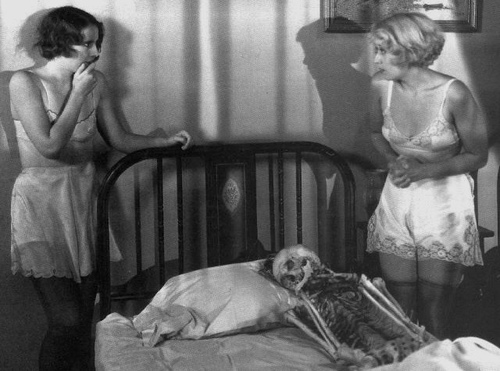
 It’s hard to believe that the Hays Code, a set of standards initiated by two religious figures and named after chief censor Will H. Hays, was enacted and enforced, to varying degrees, in Hollywood from 1934 all the way up to 1968. Film Forum is looking back at some of the racier movies made right before the code took effect in the series “Essential Pre-Code,” consisting of fifty films made between 1931 and 1934, all being shown in 35mm prints. One of the best examples of pre-code films is William A. Wellman’s rarely screened 1931 doozy, Night Nurse. The first of five collaborations between Wellman and Barbara Stanwyck, Night Nurse, based on Dora Macy’s 1930 novel, stars Stanwyck as Lora Hart, a young woman determined to become a nurse. She gets a probationary job at a city hospital, where she is taken under the wing of Maloney (Joan Blondell), who likes to break the rules and torture the head nurse, the stodgy Miss Dillon (Vera Lewis). Shortly after treating a bootlegger (Ben Lyon) for a gunshot wound and agreeing not to report it to the police, Lora starts working for a shady doctor (Ralf Harolde) taking care of two sick children (Marcia Mae Jones and Betty Jane Graham) whose proudly dipsomaniac mother (Charlotte Merriam) is being manipulated by her suspicious chauffeur (Clark Gable). Wellman pulls out all the stops, hinting at or simply depicting murder, child endangerment, rape, alcoholism, lesbianism, physical brutality, and Blondell and Stanwyck regularly frolicking around in their undergarments. It’s as if Wellman is thumbing his nose directly at the Hays Code in scene after scene. Although far from his best film — Wellman directed such classics as Wings (1927), The Public Enemy (1931), A Star Is Born (1937), Nothing Sacred (1937), Beau Geste (1939), and The Ox-Bow Incident (1943) — Night Nurse is an overly melodramatic, dated, but entertaining little tale with quite a surprise ending. Night Nurse is screening at Film Forum on July 19 as part of a triple feature with Howard Bretherton and William Keighley’s Ladies They Talk About, starring Stanwyck in one of the earliest women-in-prison movies, and William Dieterle’s Lawyer Man, which pairs Blondell with the always charming William Powell. The series continues through August 11 with such films as Rouben Moumalian’s Love Me Tonight, Frank Tuttle’s Roman Scandals, Cecil B. DeMille’s The Sign of the Cross, Josef von Sternberg’s Blonde Venus, Howard Hawks’s Scarface, Ernst Lubitsch’s Trouble in Paradise, and Merian C. Cooper and Ernest B. Schoedsack’s King Kong (bestiality!), nearly all of which are part of double or triple features.
It’s hard to believe that the Hays Code, a set of standards initiated by two religious figures and named after chief censor Will H. Hays, was enacted and enforced, to varying degrees, in Hollywood from 1934 all the way up to 1968. Film Forum is looking back at some of the racier movies made right before the code took effect in the series “Essential Pre-Code,” consisting of fifty films made between 1931 and 1934, all being shown in 35mm prints. One of the best examples of pre-code films is William A. Wellman’s rarely screened 1931 doozy, Night Nurse. The first of five collaborations between Wellman and Barbara Stanwyck, Night Nurse, based on Dora Macy’s 1930 novel, stars Stanwyck as Lora Hart, a young woman determined to become a nurse. She gets a probationary job at a city hospital, where she is taken under the wing of Maloney (Joan Blondell), who likes to break the rules and torture the head nurse, the stodgy Miss Dillon (Vera Lewis). Shortly after treating a bootlegger (Ben Lyon) for a gunshot wound and agreeing not to report it to the police, Lora starts working for a shady doctor (Ralf Harolde) taking care of two sick children (Marcia Mae Jones and Betty Jane Graham) whose proudly dipsomaniac mother (Charlotte Merriam) is being manipulated by her suspicious chauffeur (Clark Gable). Wellman pulls out all the stops, hinting at or simply depicting murder, child endangerment, rape, alcoholism, lesbianism, physical brutality, and Blondell and Stanwyck regularly frolicking around in their undergarments. It’s as if Wellman is thumbing his nose directly at the Hays Code in scene after scene. Although far from his best film — Wellman directed such classics as Wings (1927), The Public Enemy (1931), A Star Is Born (1937), Nothing Sacred (1937), Beau Geste (1939), and The Ox-Bow Incident (1943) — Night Nurse is an overly melodramatic, dated, but entertaining little tale with quite a surprise ending. Night Nurse is screening at Film Forum on July 19 as part of a triple feature with Howard Bretherton and William Keighley’s Ladies They Talk About, starring Stanwyck in one of the earliest women-in-prison movies, and William Dieterle’s Lawyer Man, which pairs Blondell with the always charming William Powell. The series continues through August 11 with such films as Rouben Moumalian’s Love Me Tonight, Frank Tuttle’s Roman Scandals, Cecil B. DeMille’s The Sign of the Cross, Josef von Sternberg’s Blonde Venus, Howard Hawks’s Scarface, Ernst Lubitsch’s Trouble in Paradise, and Merian C. Cooper and Ernest B. Schoedsack’s King Kong (bestiality!), nearly all of which are part of double or triple features.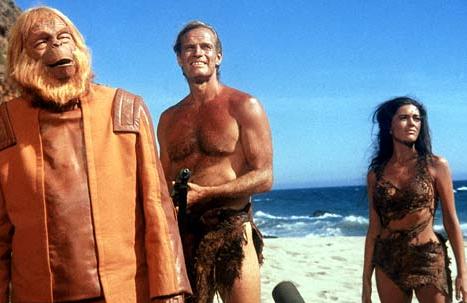
 With Rupert Wyatt’s Rise of the Planet of the Apes, starring James Franco, Frieda Pinto, Andy Serkis, and John Lithgow, scheduled to hit theaters August 5, Film Forum is bringing back the first and, by far, the best of all the Apes movies, as well as one of the best sci-fi films ever made. Based on the 1963 novel by Pierre Boulle (and with an early script by Rod Serling), Planet of the Apes offers up the nightmare scenario of a world where caged mute humans are ruled over by well-dressed speaking gorillas, monkeys, chimpanzees, and orangutans. But when astronaut George Taylor (a never better Charlton Heston) suddenly shows up — and can not only talk but is ready to fight to the death for his freedom (although he never does cry out, “Let my people go!”) — the balance of power is threatened and a final showdown is imminent. Taylor is quick to land himself a mate, the savagely beautiful Nova (Linda Harrison), and is soon befriended by an extremely intelligent and socially advanced chimpanzee couple, Cornelius (Roddy McDowall) and Zira (Kim Hunter), who take more than just a scientific interest in him. Meanwhile, Dr. Zaius (Maurice Evans) knows more than he’s letting on, and he’ll do just about anything to protect the precious, and very dangerous, secrets he is guarding. “There’s got to be an answer,” Taylor says to Dr. Zaius, who replies, “Don’t look for it, Taylor. You may not like what you find.” Indeed, Taylor and Nova head out toward one of the grandest surprise endings in the history of film. Planet of the Apes was nominated for two Oscars — Best Costume Design (Morton Haack) and Best Original Score (Jerry Goldsmith) — and John Chambers earned an honorary Academy Award for his marvelous makeup, which included turning James Whitmore into the president of the assembly. Directed by Franklin J. Schaffner, who went on to make Patton, Papillon, and Yes, Giorgio, the still fresh and original Planet of the Apes is being screened at Film Forum in a new 35mm print July 8-14, where it’s sure to be a madhouse.
With Rupert Wyatt’s Rise of the Planet of the Apes, starring James Franco, Frieda Pinto, Andy Serkis, and John Lithgow, scheduled to hit theaters August 5, Film Forum is bringing back the first and, by far, the best of all the Apes movies, as well as one of the best sci-fi films ever made. Based on the 1963 novel by Pierre Boulle (and with an early script by Rod Serling), Planet of the Apes offers up the nightmare scenario of a world where caged mute humans are ruled over by well-dressed speaking gorillas, monkeys, chimpanzees, and orangutans. But when astronaut George Taylor (a never better Charlton Heston) suddenly shows up — and can not only talk but is ready to fight to the death for his freedom (although he never does cry out, “Let my people go!”) — the balance of power is threatened and a final showdown is imminent. Taylor is quick to land himself a mate, the savagely beautiful Nova (Linda Harrison), and is soon befriended by an extremely intelligent and socially advanced chimpanzee couple, Cornelius (Roddy McDowall) and Zira (Kim Hunter), who take more than just a scientific interest in him. Meanwhile, Dr. Zaius (Maurice Evans) knows more than he’s letting on, and he’ll do just about anything to protect the precious, and very dangerous, secrets he is guarding. “There’s got to be an answer,” Taylor says to Dr. Zaius, who replies, “Don’t look for it, Taylor. You may not like what you find.” Indeed, Taylor and Nova head out toward one of the grandest surprise endings in the history of film. Planet of the Apes was nominated for two Oscars — Best Costume Design (Morton Haack) and Best Original Score (Jerry Goldsmith) — and John Chambers earned an honorary Academy Award for his marvelous makeup, which included turning James Whitmore into the president of the assembly. Directed by Franklin J. Schaffner, who went on to make Patton, Papillon, and Yes, Giorgio, the still fresh and original Planet of the Apes is being screened at Film Forum in a new 35mm print July 8-14, where it’s sure to be a madhouse.

